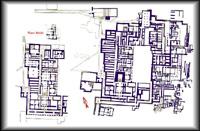Myths of Crete: The Minotaur
Part 2: The Rest of the Story But Theseus had a crafty woman on his side. Ariadne gave him a handful of string, which he was to unwind as he went, thereby letting him know which way he had come. He crept into the center of the maze, killed the Minotaur with his bare hands, and followed his string trail back out to the arms of his beloved. They somehow managed to elude the grasp of Minos and fled the island altogether. This is all well and good as a story, but is it true? Well, as with many myths, it probably has a basis in truth. Recent excavations at Knossos have turned evidence of seismic activity underneath the palace, where the labyrinth was supposed to have been. A rather convincing theory has been advanced that the underground chambers were built over an area that was prone to earthquakes. Such rumblings in the earth and their consequent noises might have sounded very much like a giant bull This is one possible explanation for the story of the Minotaur. The person thrown into the labyrinth wouldn't come back, of course, because the earthquake would have killed him.
The Greeks were very much interested in mythology and stories that taught lessons. The story of Theseus's defeating of the Minotaur could very well have been a metaphor for the Greeks' eclipsing of the once proud Minoan Civilization. Take one part confusing building pattern (the labyrinth), one part natural phenomenon (the earthquakes that sounded like a bull), add a Greek hero (Theseus), and you have a uniquely Greek story that everyone thinks is fanciful but which everyone understands. To us today, it seems like a fantasy. It may very well have had its roots in reality. First page > The Foundation of the Story > Page 1, 2 |
|
Social Studies for Kids
copyright 2002–2025
David White



 The
idea of the maze itself might very well come from the
confusing building pattern that the Palace of Knossos had.
Sculptures and paintings of the palace show it to be a
sprawling construction, with many passages appearing to lead
nowhere. Other paths take the long way around to get
somewhere. The story of the labyrinth could very well have
been a Greek attempt to disparage the greatness of the
Palace.
The
idea of the maze itself might very well come from the
confusing building pattern that the Palace of Knossos had.
Sculptures and paintings of the palace show it to be a
sprawling construction, with many passages appearing to lead
nowhere. Other paths take the long way around to get
somewhere. The story of the labyrinth could very well have
been a Greek attempt to disparage the greatness of the
Palace.

